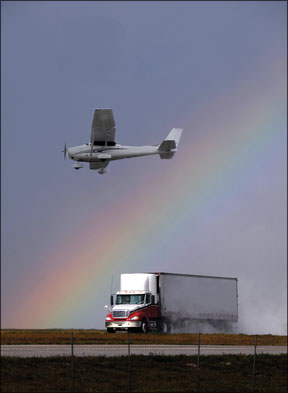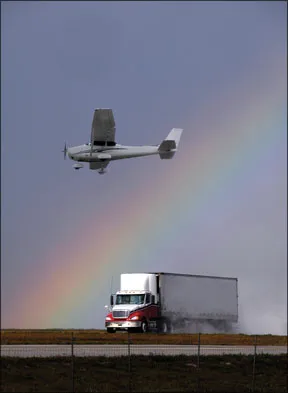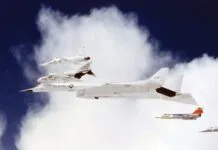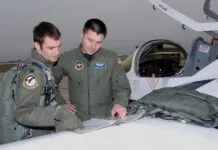Admit it. You learned what you know about scud running out behind the hangars. You picked up information furtively; senses alert for the footsteps of an instructor or even an FAA inspector who would break up your gathering, ears straining to catch every salacious morsel about something you knew had to be dirty. After all, the only place you ever heard the good stuff about getting to your destination when the weather suddenly turned bad was away from prying eyes.
Your instructor never told you anything about how to scud run, just that it

288
involved low flying and was bad, a violation of the FARs and it killed people, so dont do it. No FAA practical test guide had any portion dedicated to the skills and judgment involved in scud running. The FAAs texts didnt discuss how to scud run, if they addressed it; it was only to admonish you not to do it. Yet, without formal training, without reasoned discussion, in the face of stern warnings not to do so, pilots scud run. And every year, a large number of those who attempt to scud run, die.
A Little History
Scud running is the technique of flying very low to stay out of crummy weather. It was taught during flight training and regularly practiced for the first several decades of flight when, initially, instrument flight was not an option and, later, only a small proportion of airplanes had instruments. It was most successful in relatively flat territory and almost suicidal in any sort of mountainous terrain.
The first professional pilots in the U.S. were airmail pilots. To avoid weather, they often flew but a few feet above the planet. Even in daytime, the accident rate was not pretty, especially in the Alleghenies and Rockies. Trying to fly without the benefit of good instrumentation (and training in how to use it) or radio navaids meant that foul weather flying was lethal.
Nevertheless, particularly in the mid-section of the country, scud running could be practiced so long as the visibility wasnt too bad (fog and snow were killers) because a pilot could motor along 30 feet above a road knowing he was above the power lines and that broadcast antennas were located in the towns. All radio was AM, not limited to line of sight. For economy, the towers were put up on or beside the broadcast stations, not out in the country. In the late 20s, Henry Fords airline running between his auto manufacturing plants boasted on the order of a 95 percent on-schedule record, simply because the pilots could fly incredibly low and not have to worry about hitting anything.
The times, they have a-changed.
Stuff Sticking Up
Nowadays, there are scores of antennas in the country, broadcast antennas on any relatively high piece of ground and cellular telephone towers virtually everywhere, particularly at short intervals close beside the more heavily traveled highways. Our populace demands to be in cellphone contact all the time, so the providers have complied by erecting towers on almost anything that doesnt move.
Towers may or may not be tall enough to require placement on charts (and entry in GPS databases). Most are required to be lighted; however, next time you go for a drive, glance around and see if you see any that arent. You may be surprised. Also, notice how many are close to the Interstate. Consider that those lighted 2000-foot-tall towers you see have several sets of guy wires that may spread out as much as 2000 feet. They are not lit.
For an interesting exercise, grab a sectional chart and pick an airport about 100 nm from your home airport. Draw a line to it. Then count how many towers are within a mile or so of the line. Take a look at their heights and imagine flying the line at 500 feet agl. Eye-opening, isnt it?
High-tension, cross-country electrical transmission lines can be a couple of hundred feet off the ground. Their numbers are increasing as our population grows and demand increases, and as wind generators are built in remote locations (wind generators can be about 450 feet tall to the highest blade point, and the blades themselves are not lit) and their power is transmitted to population centers. Crop dusters will tell you in no uncertain terms that most of the time you cannot see power lines from any distance; you have to spot the poles. If you are flying low in a valley, to stay below clouds, there is a good chance there will be power lines strung completely across the valley from the adjacent hillsides. There will be no poles in the valley itself to warn you of the lines. I lost an acquaintance to just that set of circumstances; wires took one wing off the T-34 he was flying in a valley.
What Can You See?
The sight picture presented to the scud-running pilot deserves some serious contemplation simply because it is so vastly different from what a pilot normally sees in day-to-day flying. Lets take a day when the ceiling has dropped to 800 feet agl. Airspace legalities aside, the pilot is going to be flying some distance below the clouds. If the cloud bases are ragged, as they often are in bad weather, trying to fly at 700 feet may not work as visibility may be awful, so going down to 500 or 400 feet agl may be necessary to see anything ahead or have any sort of a visible horizon.
Has the pilot ever flown level at 500 feet agl for any length of time? Its a different sight picture and, among other things, one cant see as far and the horizon seems higher. Chances are the pilots instructor never put that in the training syllabus.
The first time a pilot tries it, the adrenalin level is somewhere near stratospheric and the pilot, who is used to being a lot higher and has never been too terribly particular about holding altitude within plus or minus 100 feet, suddenly has a brand-new perspective on the world where precise altitude becomes a matter of life and death. Trimming the airplane accurately becomes important. Is the pilot in the habit of always trimming the airplane so it does not wander when looking down at a chart, the instruments or the GPS? All of a sudden, little bad habits can have massive repercussions.
If the weather is merely low ceilings, with no restriction to visibility, the pilot may have a fighting chance; so long as he or she can manage to navigate (the airplane may be too low for VOR reception) and keeps her or his head up to watch for towers, power lines and any other poor sucker who might be optimistically flying in the area.
The next step is to toss in restrictions to visibility. In the days pilots scud ran on purpose, they generally wouldnt depart with the visibility below about three or four miles. Cruising along at 120 mph, they had time to look quickly inside the cockpit, look back up, let their eyes adjust and have a fair chance of spotting something before hitting it. (Although the tremendous problem of spotting power lines took a number of those folks out even in four-mile visibility.
Reduce visibility to one or two miles-legal for VFR in a lot of airspace when down low-and things really get toxic. There is no decent horizon for roll and pitch reference. Talk with an instrument pilot about his or her first circle-to-land approach in real conditions, about trying to maneuver the airplane for the airport in a mile or so visibility and how tough it was to split attention between the instruments needed to keep the airplane right side up at the desired altitude, keeping the airplane below the clouds and maneuvering it toward the runway.
One of the most confusing things for a new instrument pilot on a circle-to-land approach is that in one-mile visibility, flying what is a normal pattern to the pilot means being so far away from the airport as to lose sight of it. Consider your “normal” traffic pattern, its altitude and distance from the runway, especially where you turn base. If you are flying in one-mile visibility, even if you find the airport, can you keep it in sight while you fly the pattern?
In two-mile visibility at 120 miles per hour, the airplane covers the distance the pilot can see ahead every 60 seconds. In one-mile viz, that time is reduced to 30 seconds. Now consider cross-checking instruments as you try to keep the airplane under control, look at the map or GPS and then outside. Imagine looking up to see a hill or tower or power line looming out of the haze too close to miss. There will be people at your funeral saying stupid things like “at least he died doing something he loved.”
You wont be around to tell them that you didnt love being utterly terrified the last few seconds of your life, or about the horrible guilt you were feeling as you became absolutely certain that your decisions had doomed everyone aboard.
Oh, and how well do you know the area over which you are flying? Oklahoma is flat, right? Not the east end of it. It has mountains. Every year a few pilots ignorant of that bit of geography pay for their lack of knowledge with their lives when the weather is foul. Is the high pass east of Cheyenne, Wyo., among the mountain peaks? Nope, its on what appears to be open rangeland that fools a few pilots each year as the seemingly flat ground slopes up into the clouds as they try to scud run along Interstate 80.
Practicalities
We respectfully point out that pilots are pretty capable people, however, when under stress they do not have a good record of successfully accomplishing tasks they have not practiced. Its reflected in the accident stats from attempts to scud run. We therefore suggest that no pilot even consider adding scud running to his or her bag of tricks until going out with an instructor and actually seeing what its like to fly in two-mile visibility with a 900-foot ceiling. It doesnt take a long flight, just stay in or near the pattern.
Seeing the weather for real is probably enough to make an educated decision as to whether you want to attempt flying in such slop away from an airport, with the most important people in the world on board, your family. We suspect youll decide it simply isnt a good option.
What about legality? First of all, you have to be alive to be violated by the FAA for low flying. Once past that, the regs say youve got to be high enough to make a successful forced landing if an engine fails. How high is that where youre flying? Your call.
You also have to be 1000 feet over the highest obstruction over congested areas. The FAA has defined congested areas as such things as four houses in a quarter mile, a four-house housing development in the middle of farm fields, and, get this, a highway with several cars on it. The definition is much more restrictive than most pilots realize. So, when making the decision to fly at 300 feet over a highway to get home, if there are more than a very few cars on that highway, you might find yourself busted for low flight over a congested area-and the FAA is getting help with those charges from people with cellphone cameras who dont like or are scared of little airplanes. Again, your decision.
Oh, there are towers built between the roadways on divided highways. And some of them have guy wires that cross over the roadways. Can you keep the airplane over the highway, divide your attention between outside and inside, and not let the airplane drift 200 yards to the right of the highway where the cell phone towers live? Can you spot each and every obstruction before you hit it? In two-mile visibility?
It is a test and the only passing grade is 100 percent.
For Further Information…
We suggest scud running be discussed in a mature faction so an intelligent group of people-pilots-can think about whether it is an effective tool before trying to use it when they hit unforecast bad weather. Thinking and talking about it, and flying with an instructor in sloppy weather may cause a few pilots to make better decisions when it is for real. They can reject an attempt to scud run and stay alive by turning around, or making a precautionary landing or climbing and getting help from ATC. They can make a decision that will have a far better chance of keeping them alive than scud running.
Rick Durden is a practicing aviation attorney and type-rated ATP/CFI with more than 7000 hours.




